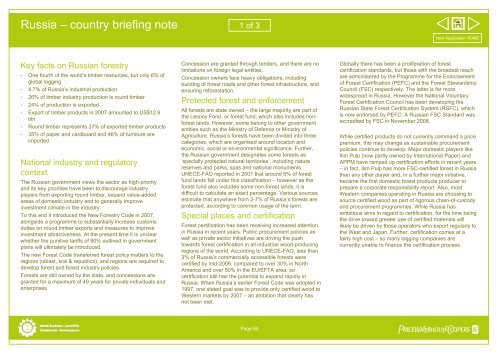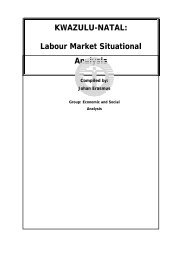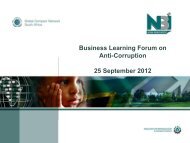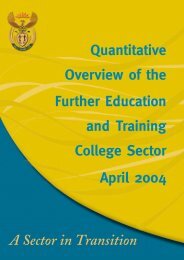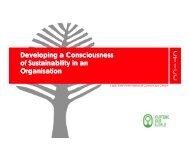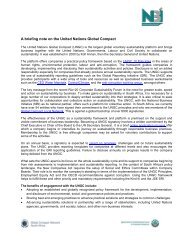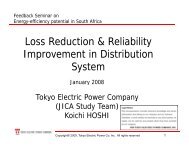Sustainable Forest Finance Toolkit - PwC
Sustainable Forest Finance Toolkit - PwC
Sustainable Forest Finance Toolkit - PwC
- No tags were found...
You also want an ePaper? Increase the reach of your titles
YUMPU automatically turns print PDFs into web optimized ePapers that Google loves.
Russia – country briefing note 1 of 3New Application HOMEKey facts on Russian forestry• One fourth of the world’s timber resources, but only 6% ofglobal logging• 4.7% of Russia’s industrial production• 26% of timber industry production is round timber• 24% of production is exported• Export of timber products in 2007 amounted to US$12.6bln• Round timber represents 37% of exported timber products• 35% of paper and cardboard and 46% of furniture areimportedNational industry and regulatorycontextThe Russian government views the sector as high-priorityand its key priorities have been to discourage industryplayers from exporting round timber, expand value-addedareas of domestic industry and to generally improveinvestment climate in the industry.To this end it introduced the New <strong>Forest</strong>ry Code in 2007,alongside a programme to substantially increase customsduties on round timber exports and measures to improveinvestment attractiveness. At the present time it is unclearwhether the punitive tariffs of 80% outlined in governmentplans will ultimately be introduced.The new <strong>Forest</strong> Code transferred forest policy matters to theregions (oblast, krai & republics), and regions are required todevelop forest and forest industry policies.<strong>Forest</strong>s are still owned by the state, and concessions aregranted for a maximum of 49 years for private individuals andenterprises.Concession are granted through tenders, and there are nolimitations on foreign legal entities.Concession owners face heavy obligations, includingbuilding of forest roads and other forest infrastructure, andensuring reforestation.Protected forest and enforcementAll forests are state owned – the large majority are part ofthe Lesnoy Fond, or forest fund, which also includes nonforestlands. However, some belong to other governmententities such as the Ministry of Defence or Ministry ofAgriculture. Russia’s forests have been divided into threecategories, which are organised around location andeconomic, social or environmental significance. Further,the Russian government designates some forests as‘specially protected natural territories’, including naturereserves and parks, spas and national monuments.UNECE-FAO reported in 2001 that around 5% of forestfund lands fall under this classification – however as theforest fund also includes some non-forest lands, it isdifficult to calculate an exact percentage. Various sourcesestimate that anywhere from 2-7% of Russia’s forests areprotected, according to common usage of the term.Special places and certification<strong>Forest</strong> certification has been receiving increased attentionin Russia in recent years. Public procurement policies aswell as private sector initiatives are driving the pushtowards forest certification in all industrial wood-producingregions of the world. According to UNECE-FAO, less than3% of Russia’s commercially accessible forests werecertified by mid-2006, compared to over 30% in NorthAmerica and over 50% in the EU/EFTA area, socertification still has the potential to expand rapidly inRussia. When Russia’s earlier <strong>Forest</strong> Code was adopted in1997, one stated goal was to provide only certified wood toWestern markets by 2007 – an ambition that clearly hasnot been met.Globally there has been a proliferation of forestcertification standards, but those with the broadest reachare administered by the Programme for the Endorsementof <strong>Forest</strong> Certification (PEFC) and the <strong>Forest</strong> StewardshipCouncil (FSC) respectively. The latter is far morewidespread in Russia. However the National Voluntary<strong>Forest</strong> Certification Council has been developing theRussian State <strong>Forest</strong> Certification System (RSFC), whichis now endorsed by PEFC. A Russian FSC Standard wasaccredited by FSC in November 2008.While certified products do not currently command a pricepremium, this may change as sustainable procurementpolicies continue to develop. Major domestic players likeIlim Pulp (now partly owned by International Paper) andAPPM have ramped up certification efforts in recent years– in fact, Ilim Pulp has more FSC-certified forest in Russiathan any other player and, in a further major initiative,became the first domestic forest products producer toprepare a corporate responsibility report. Also, mostWestern companies operating in Russia are choosing tosource certified wood as part of rigorous chain-of-custodyand procurement programmes. While Russia hasambitious aims in regard to certification, for the time beingthe drive toward greater use of certified materials willlikely be driven by those operators who export regularly tothe West and Japan. Further, certification comes at afairly high cost – so many logging companies arecurrently unable to finance the certification process.Page 65pwc


